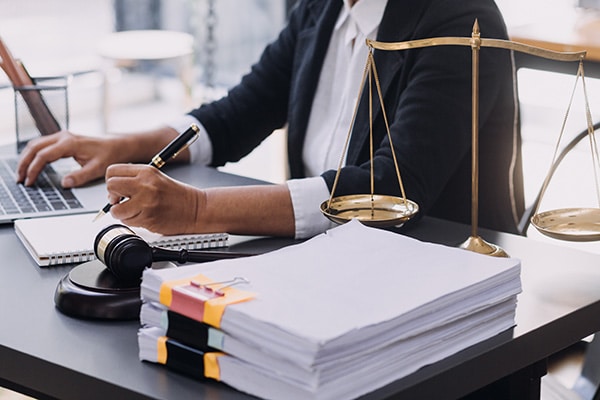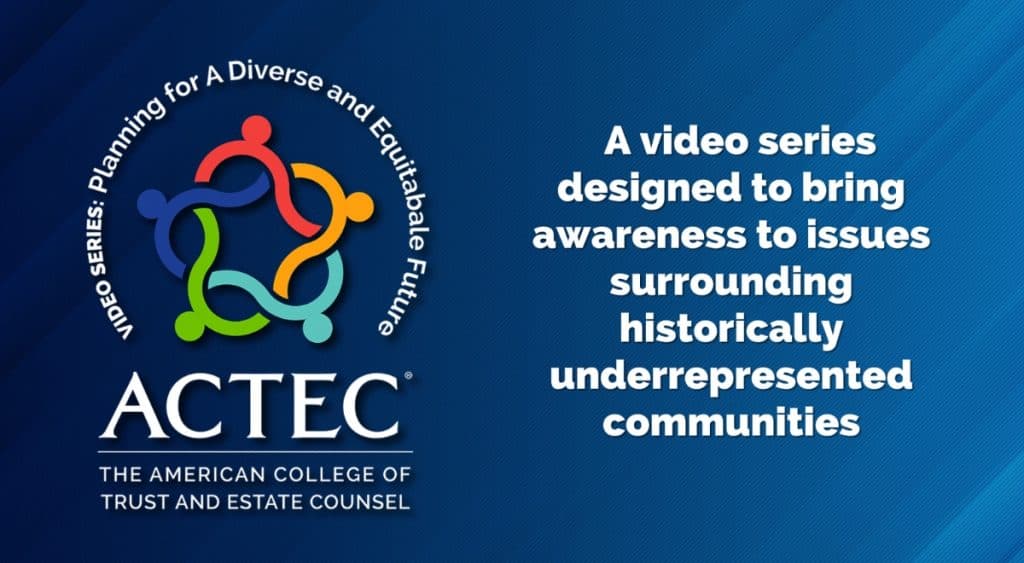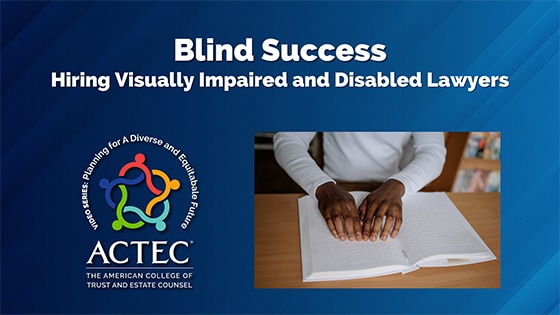Systemic racism in the legal profession refers to the ingrained structural biases and practices that disproportionately disadvantage racial minority lawyers, leading to disparities in representation, opportunities, and outcomes. How does society treat individuals of different races, sexes and beliefs? The 2020 ABA Profile of the Legal Profession report offers statistics and information that reveal how the legal profession is doing with diversity and inclusion.
The Honorable Ashleigh Parker Dunston of North Carolina has written extensively about her experience with systemic racism. ACTEC Fellow Paula Kohut discusses biases in the legal profession, Judge Dunston’s recent article “Justice Isn’t Always Blind” in the North Carolina State Bar Journal and her recommendation for the legal system and people of diverse backgrounds.

Resources
- 2020 American Bar Association – Profile of the Legal Profession’s 2020 Report
- Articles by the Honorable Ashleigh Parker Dunston:
- Implicit Association Test
Transcript
ACTEC Fellow Terrence M. Franklin: Today, we have the privilege of talking with Judge Ashleigh Parker Dunston. Judge Dunston serves in the Tenth Judicial District of North Carolina. She is a rarity on the bench there since she is female and African American. ACTEC Fellow Paula Kohut, also from North Carolina, interviews her today about her experience with systemic racism as a woman of color in the legal profession.
Overview of the Racism and Diversity Issue in the Legal Profession
Paula A. Kohut: Thank you, Terry. Judge Dunston, we appreciate your willingness to discuss this important topic on diversity of the American legal system. The findings in the American Bar Association’s “Profile of the Legal Profession’s 2020 Report” revealed that diversity in the legal profession has been static. The number of female lawyers in the U.S. has only increased by 6%, from 31% to 37% between 2010 and 2020.
In 2010, 89% of all lawyers were non-Hispanic whites. Ten years later, the percentage only decreased by 3%. In 2020, as in 2010, only 5% of all lawyers were African American despite comprising 13.4% of the U.S. population.
The report also found four of five judges in 2020 were white, and the percentage of African American judges actually dropped from 10.8% in 2016 to 9.8% in 2020. These facts demonstrate the persistence of inequity and systemic racism in the legal profession and the need for the legal profession to recognize and take action to eliminate racial disparities.
Judge Dunston, you wrote the article “Justice Isn’t Always Blind,” which was published in the North Carolina State Bar Journal in the Fall of 2020. Could you share with us what inspired you to write that article?
Justice Isn’t Always Blind
Judge Ashleigh Dunston: Thank you so much, Paula, for having me and allowing me to participate in this video. The reason why I wrote the article “Justice Isn’t Always Blind” was actually a buildup. For several years I’ve been writing articles that have ranged from “Sexism: The Elephant in the Courtroom,” where I discuss sexism, and then I went to “My Crown is Professional,” which deals with African American and Black women in our natural hair to “Three Ps of Being a Prosecutor,” which talks about prosecutorial discretion and what it’s like to be a minority prosecutor. I was one prior to becoming a judge, as well as an Assistant Attorney General, and so I wanted to raise awareness of that.
So this has really been a buildup, and with the incident with George Floyd and Brianna Taylor and just kind of the racial dynamics of our country, I knew that it was the moment and the time to now bring out the racial dynamics and the issues that we’re having within our legal profession. I think it’s important to know that it doesn’t matter if you are a judge or an attorney, how much education that we have, what bar that we passed, that we’re all still dealing with the same racial dynamics. And it’s unfortunate. And it’s also, I would say, damning to our profession and to us as attorneys. And so, I really wanted to bring that to the forefront, and so I did something similar that I’ve done in all the other articles that are written and that’s to collect testimonies from individuals that have experienced these things. So the article “Justice Isn’t Always Blind” does just that. It takes the experiences of African American attorneys from across the state of North Carolina, and It ranges all the way from things such as being asked for your “bar card.” Are you the defendant? Ranging all the way up to being called the N word. So it’s just so many different stories in there and just so many different brave individuals that have had to face a lot; because it’s a lot to be an attorney and then to turn around and have to deal with something else because of your race as well.
Paula A. Kohut: And could you share some of those? They’re pretty powerful life experiences. Do you mind sharing a few with us?
Examples of Discrimination in the Law
Judge Ashleigh Dunston: Sure. I think that the one that really stands out to me is the one where one who is now a judge – was a prosecutor – and he had been called the N-word, and now that individual still appears in front of him today. You never know where someone’s going to end up. There is someone now that is the public defender for his county, and whenever he was looking for a job and interning, he was told to pretty much “go try out a chicken farm if law school doesn’t work out.”
My dad was the first African American prosecutor on the western side of the state of North Carolina, and he dealt with a lot of adversity being the first black man to prosecute and, in fact, there was a judge that would not allow him to try cases against white defendants just because he was black. It’s just so many different things. There’s a black female judge that was questioned about what she is doing, where she is going, and another judge asking her to “get me some napkins, sweetie” like she was a servant.
I mean there are just so many different ways and things that we see. And I think the interesting thing for me was to have individuals from across the state who did not submit a testimony come back to me later and say – I had to check to see if I had submitted a testimonial to you because I could relate to every single one of those stories and I just wanted to make sure that it wasn’t mine. It just shows you how pervasive racism is within the profession and how much work we need to do to make sure that we end it.
Paula A. Kohut: Is there any advice you might offer to young diverse lawyers who are considering entering the profession?
Advice to Young Lawyers of Color
Judge Ashleigh Dunston: Absolutely. I would say, number one, just to know that it is going to happen. I would say to make sure that you are staying educated on everything that you need to know about the profession and come in strong. Do not be intimidated by other individuals that might be older than you or you feel like are more experienced than you. You took the same bar. You went to law school. You graduated. You are capable of doing just as much work as they are and you are just as good as they are.
The other thing is, I would make sure that you have a mentor. I have mentors throughout every single stage of my professional career that I still have ties to. These are important for multiple reasons, but mainly to bounce ideas off of. To make sure that if you are treated in a disparaging way, that you have someone that you can talk to. Someone that will advocate for you if you don’t feel comfortable doing it yourself. But then, also to make sure that they’ve got somebody that has their back and making sure that your mental health is secure.
Paula A. Kohut: I think when we were talking before the video, you had shared that, using the power of being underestimated. Could you expand on that a little bit for us?
Judge Ashleigh Dunston: Absolutely. For me, being a young black female – I was 30 years old when I entered the bench. I was 24 when I started practicing. So I’ve dealt with a lot of things from the racism to the sexism to the ageism. And the thing for me is, especially when I was Assistant Attorney General and I was traveling across the state, I had a lot of different experiences where people just completely ignored me. I’ll never forget one time I was in a smaller county, and we were doing the counter calling superior court and I was standing up to say who I represented and the other attorney said that the Attorney General’s office didn’t send anybody. And I’m literally standing right there. And so I just remember what that felt like to feel so small and just feel unseen. But I just remember at that moment standing up a little bit taller and a little bit stronger and just saying with authority, “My name is Ashley Parker Dunston, Assistant Attorney General here on behalf of the Division of Motor Vehicles and I represent the division and I anticipate this matter taking 30 minutes.” At which point I tried the case, won the case, handed up my proposed order, dropped the mic, exited stage left and drove back to Raleigh. You know, that was just the way that I did things.
And so, I think for me, the main thing is to take that underestimation and make it your secret weapon. The fact that people will see you and think something about you and will have a predisposed idea of you does not mean that you have to submit yourself to that. So you need to just make sure that you are always ultra-prepared, that you have everything that you need to have and just be ready to show them better than you can tell them how qualified you are to be in the position that you’re in.
Paula A. Kohut: Thank you. As we’re talking about in this series – Planning for a Diverse and Equitable Future tries to make recommendations to improve our profession and make way for a diverse future, what recommendations do you have for lawyers, both young and old?
Recommendations to Adress Racism in the Legal Profession
Judge Ashleigh Dunston: I think the main thing is to, number one, recognize your implicit biases. You want to make sure that you are aware we all have them. So you need to educate yourself. There’s actually a test, and you can just type in IAT (Implicit Association Test) into Google; and Harvard has created a test. It’s awesome, which will help you start to figure out what these biases are. The other thing is to be aware of microaggressions that you may not even mean to say. Things that you may say to someone that you don’t even mean to such as, when I do a CLE, you know, someone comes up at the end and I think they’re complimenting me when they say, “Oh you’re so well spoken; I didn’t expect that.” Or, “Oh your people just need to be so proud of you.” You would just not imagine some of the things that, you know – I’ve even had a professor come up to me and say, “Do you think that you got to where you are because of how pretty you are?” You know, and it was just mind-boggling that somebody would say these things – that they actually think it’s a compliment and it’s not.
So just be careful about what you say to people. The other thing is to educate yourself on the experiences of other individuals. Make sure that when we are talking about diversity and we’re talking about inclusivity, that you actually are being inclusive. And that means that – are you figuring out ways to have this individual feel like they’re a part? Are you listening to the things that they want to do or are you constantly always doing a golf tournament? Golf is fine. My parents play it all the time. That’s fine. But I’m just saying, are you saying you need to come into our environment? Are you being willing to expound your environment to include other people? So you need to ask yourself that.
You also need to make sure that if you are in these spaces and you look around and there is no one of color or no diversity, no woman, anyone different than you that has different ideas, then you need to bring those individuals into that boardroom, into that forum, into that space so they can have to make ideas and decisions as well. So it’s just something that we can all do to make changes, I think. You know, we want to make sure that discrimination is not occurring. Rule 8.4 (g) of the ABA rules – we’re trying to see if we can incorporate those into our North Carolina Rules of Professional Responsibility. As a judge myself, I believe that it needs to be in our Canons as well, our judicial Canons to make sure that discrimination is not allowed in our profession.
We all have a job. We all have an obligation to make sure that every individual that works in our profession and appears in front of us or is a part of the legal system feels seen, feels heard and is not discriminated against.
Paula A. Kohut: Thank you, Judge Dunston. It’s been a privilege to discuss your article with you and the future of the legal profession today; and we wish you the very best. Thank you.
Judge Ashleigh Dunston: Thank you so much.
ACTEC Fellow Terrence M. Franklin: What an inspiring interview! “Every person needs to feel seen and feel heard in the legal profession.” Judge Dunston’s passionate words and insight offer lawyers and the U.S. legal system a road map to reduce racism. How will you do your part to effect positive change in our profession?
Please visit ACTEC, actec.org/diversity for resources on increasing diversity in the legal profession. And make sure you subscribe to ACTEC’s YouTube Channel to be informed of new videos as they become available.
Featured Video
Blind Success: Hiring Visually Impaired and Disabled Lawyers
An ACTEC Fellow describes his journey as a blind lawyer: lessons learned, job support, and recommendations for law firms hiring individuals with disabilities.
Planning for a Diverse and Equitable Future

ACTEC’s diversity, equity, and inclusivity video series analyzes issues surrounding racism, sexism, and discrimination in all its forms to combat inequality.

